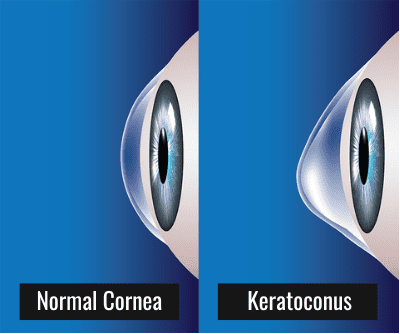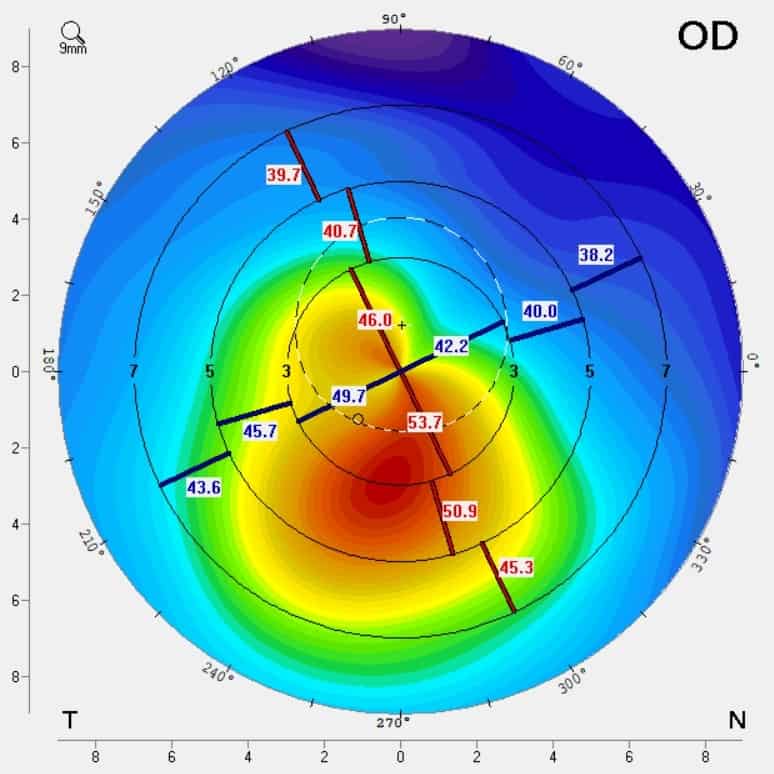What is Keratoconus?
The cornea (kaw-nee-uh) is the clear structure at the very front of your eye. It is in front of the iris (blue or brown part of the eye) and it focuses the light entering your eye. The cornea normally has an even, symmetrical shape, like half a soccer ball. When someone develops keratoconus, the cornea becomes distorted and irregular in shape.
This causes the vision to become blurred because the light isn’t focussed accurately in the eye. Keratoconus is an uncommon condition affecting about 1 in 250 people.
Keratoconus usually affects both eyes but one eye may be much more affected than the other.

What causes Keratoconus?
The cause of keratoconus is not fully known but many people with the condition also suffer from other issues such as allergies in the eyes, asthma, eczema and hay fever.
It is more common in males and some cases have a genetic component, with other family members affected.

What is the prognosis for someone with Keratoconus?
Keratoconus typically starts to affect people in their teenage years and then continues to worsen throughout their 20s and sometimes into their 30s. Keratoconus does not send people blind but depending on how severe the condition becomes, people may need high powered glasses, specially made contact lenses or in some case, major corneal surgery to achieve good vision.
How is Keratoconus treated?
There are 2 parts to the treatment of Keratoconus. These are to stop the condition worsening and to improve the vision.
Treatment to Stop Keratoconus
Keratoconus typically gets worse throughout people’s teenage years, 20s and sometimes into their 30s. We are fortunate now to have a very effective treatment that stops this progression and can prevent Keratoconus becoming severe.
This treatment is called Corneal Collagen Crosslinking. (Click for more information on corneal collagen cross linking).
Ways to improve the vision of people with Keratoconus
- Glasses – for people with mild Keratoconus, glasses may be sufficient to give clear vision. For moderate or severe cases, glasses will provide some improvement to the vision but will not make the vision clear
- Contact lenses – there are many types of contact lenses now available to patients with Keratoconus and most patients will be able to achieve clear vision. These contact lenses are fitted by optometrists with a special interest in Keratoconus.
- Laser treatment – this is a modification of the common type of laser refractive surgery which can reduce the need for contact lenses or spectacles
- Surgery – several surgical options now exist.
- Corneal transplant – in severe cases of Keratoconus, a corneal transplant, also known as a corneal graft, is the process of replacing the mis-shaped cornea with a donor corneal
- Corneal segments – the corneal shape can be made more ‘normal’ by manipulating the corneal shape by placing support rings into the cornea. This is called Intra Corneal Ring Segments (ICRS).
How do I know which treatment is right for me?
Dr Drury is a corneal specialist and after examining your eye, will determine if your Keratoconus is progressing, or stable and then discuss the suitable treatments to help you achieve good vision.
For more information on Keratoconus check out: https://www.keratoconus.org.au/

